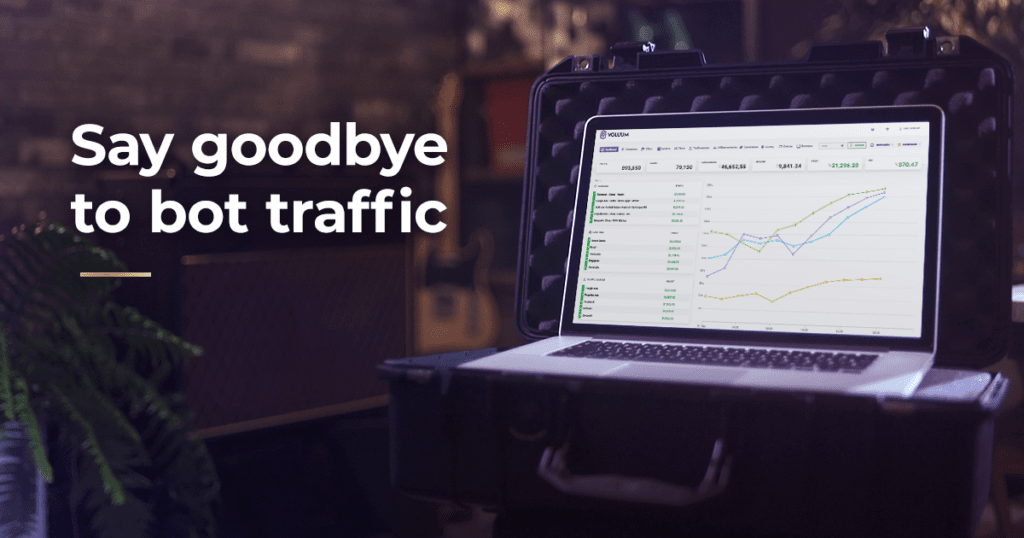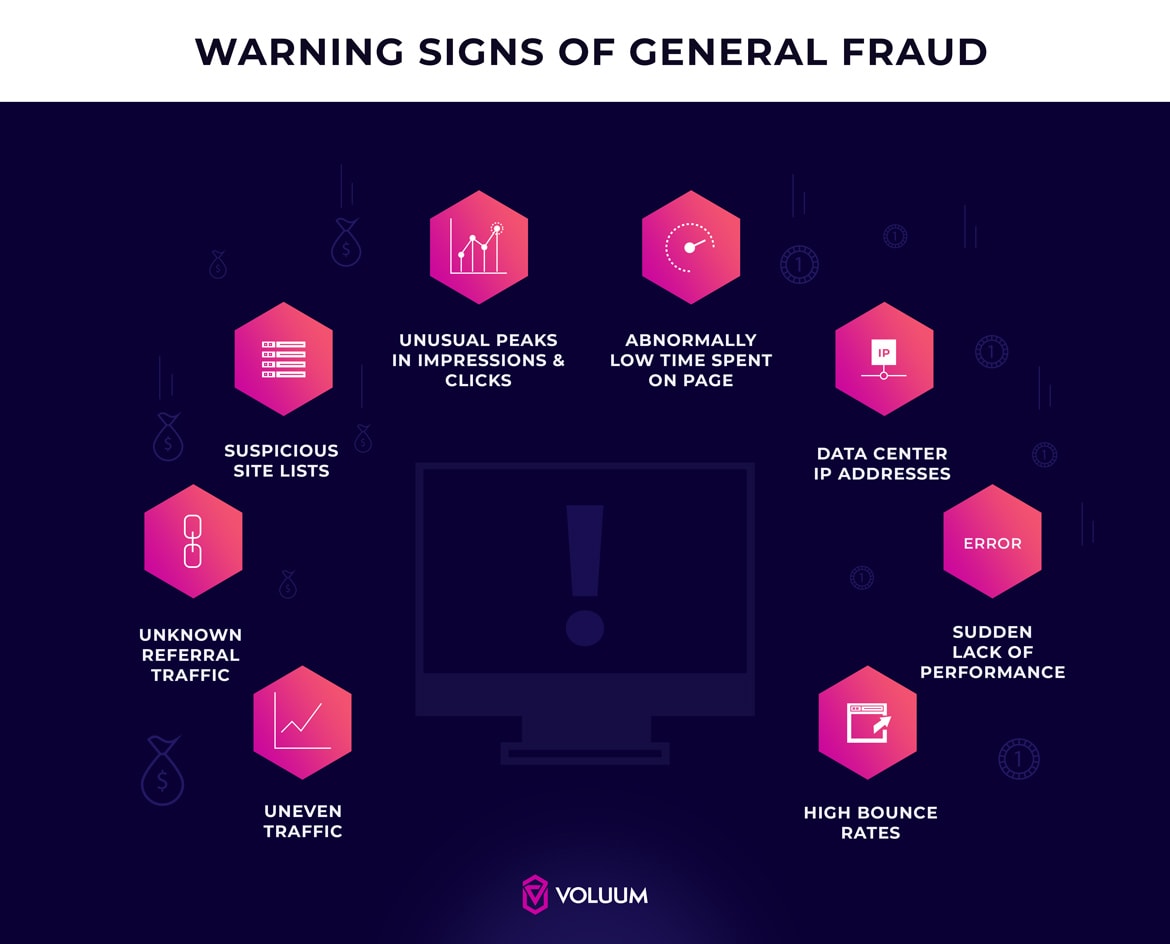Digital Ad Fraud is hitting new highs.
If you read my previous post on Ad Fraud, you already know that it is a critical problem in our industry; guilty of burning out budgets and payouts of millions of advertisers.
Today I would like to focus on ways of solving it.
In this article, I will guide you through the process of uncovering and preventing fraudulent activities. You will find out what are the warning signs of fraud and how to prevent it by implementing anti-fraud strategies.
We’ll start the less the sophisticated fraudsters, fond of messing out with our impressions.
The warning signs of general fraud
As you already know, general fraud is the most common type of Ad Fraud. Fraudsters use various tactics like ad stacking, bundling, bots and many more to mess up impressions metrics. Lucky for us, this kind of activity is relatively easy to detect.
What are the warning signs of general fraud?
- Data center IP addresses – Analyze the IP addresses of your ads’ clickers. If most of your “visitors” originate from one server, you probably have no real visitors. Additionally, a list with IP addresses can be used as a legitimate proof for an agency or an ad-buying platform if you would like to get a refund for the fake traffic.
- Unknown referral traffic – If you suddenly start to see a peak in your referral traffic or hordes of users checking your site directly every day, it’s probably fake.
- Suspicious site lists – Something else to watch out for is a very large number of long-tail site placements in your campaign reports. Real human visitors go to recognizable publishers rather than suspicious-looking websites.
- Uneven traffic – If you see an unusual increase in your page views and you haven’t recently run a big campaign or made any serious changes on your website, fraudsters may be behind your metrics.
- Abnormally low time spent on a page & increased bounce rates – As bots are programmed to perform their tasks at high speeds, they can crawl numerous pages within a small time frame. If you see many page duration metrics which only span a few seconds, then you might be looking at the bot activity.
How to prevent general fraud?
Even if you check your traffic sources and work with reputable ad exchanges and publishers, ad fraud will probably find its way to you. There are a few things that you can do to secure your campaigns:
- Block suspicious IPs – Most fraudsters drive multiple conversions from the same IP or a very similar one, going in the ascending or descending order. To limit fraudsters’ reach, you can block them. If you’re a Voluum user, you can use our built-in functionality to filter suspicious IP addresses and unrecognized devices. This feature will allow you to block unwanted traffic from certain IP addresses and ranges or block certain user agent names.
- Take advantage of auto-optimization – apply the machine learning algorithm that automatically optimizes your campaigns towards your specified performance goals such as CPV, CPC pr iCTR. It will redistribute your traffic from the underperforming traffic sources and save you a penny by limiting your spend on low-quality traffic.
- Create whitelists and blacklists – By monitoring your performance and incorporating your knowledge about the best and worst performing placements into your whitelists and blacklists, you can actively eliminate low-quality traffic; remember to maintain them on a very regular basis.
- Set auto-rules – set up the conditions to make sure the system will be constantly checking and pausing underperforming elements based on the defined criteria in the conditions.
- Set frequency filtering – to make sure bots won’t score numerous fake impressions at your cost, set the maximum number of times a user should see your ad.
Fighting Sophisticated fraud
With sophisticated fraud, the case is a bit more complicated. What can indicate fraud? The most obvious sign is low-quality conversions.
If the conversion rate of your campaign is significantly higher than the average campaign conversion rate on any given traffic source, it can be a big red flag.
As sophisticated fraud is quite rare and extremely hard to spot, your leeway is narrowed. Luckily, your hands aren’t completely tied.
Even though fraudsters go out of their way to disguise their malicious activities, they leave behind a lot of digital footprints. How to discover them?
The Art of Investigation
The only way to fight and prevent sophisticated fraud is by conducting regular inspection of your traffic. It might be an exhaustive job, but digging into your reports is the right thing to do.
- Vet for Quality Control – Work with ad networks that will help you detect, prevent, and fight ad fraud systematically. Take a look at Zeropark, which leverages third-party and in-house solutions for automatic bot prevention. Combining deep-dive analysis of bids & wins with the use of Honeypot technology enables them to effectively identify sources of fraudulent traffic.
- Check every potential partner – Examine the websites where your ads will be displayed. Check if there aren’t any suspiciously high volumes of traffic on a newly registered domain, a strange domain portfolio or other pre-existing fraudulent behavior. Make sure the websites pass through all of your preliminary checks and align with your offer.
- Examine traffic quality regularly – Spooling through a list of domains in which your ads appear can be a monotonous task, however, it is worth keeping an eye on this. Look out for ghost sites, low-quality sites and make a list of domains you definitely do not want to appear. This could be a huge risk from not only a fraud point of view but from a brand angle too. To make sure you are paying for as little fraud as possible, continuously work on identifying issues and low-performing traffic sources. Look for patterns.
- Oversee your advanced metrics – Keeping an eye on the time-to-convert metrics, user retention metrics, traffic distribution patterns (with clicks) or behavior on landing page patterns will allow you to identify anomalies when they occur. Again, look for patterns. Maybe the time between the click and the install is significantly longer than for the usual traffic? Or there’s a huge number of installs with no post-install activities? Or a high iCTR rate on native ads, but no clicks on the landing pages? Once you determine a pattern, you can blacklist specific IPs and publishers for a future reference.
- Report Fraud asap – Once you spot fraudulent traffic, reach out to your traffic source with the most detailed reports possible. If more is known about the sources of bad traffic, then more effective action can be taken. When fighting fraud, time is money. Literally. The faster you deliver all the necessary information, the faster they will be able to deal with the problem.
- Monitor your performance and partners on the go – Continually check your current inventory to make sure that your publishers haven’t made costly changes on their websites.
- Invest in a third-party solution – There are tools on the market, like Pixalate, that will filter out bot traffic, proxy traffic, identify malicious ad content and bypass clocking. If you feel that you need more advanced protection do your research and choose a legitimate, trustworthy and capable partner.
Summary
Ad fraud is obviously a massive problem for advertisers, but it’s also an existential risk to the ad industry as a whole. Detecting ad fraud and removing it from your own campaigns is the first step to eliminating it from our entire advertising landscape.
As there’s more than one type of ad fraud and zero easy solutions, it’s critical to do your homework if you want to generate some serious profits. Always dig into your analytics and try to investigate any anomalies that will come through your campaigns.
By setting reasonable goals for clean traffic, blocking bad traffic, but also diagnosing the cause and eliminating it, you can reduce the size and impact of the ad fraud problem.
Get rid of bot traffic with Voluum Anti-Fraud Kit. Learn more!






